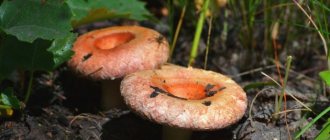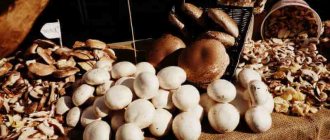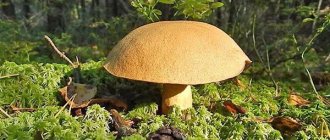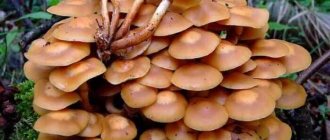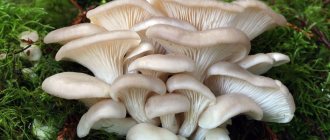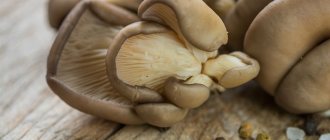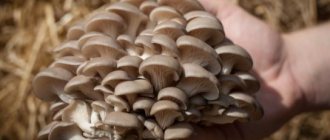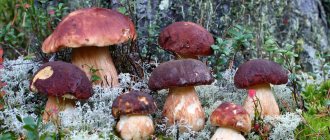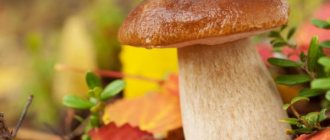Mushrooms
0
1923
Article rating
Kira Stoletova
The answer to the question whether false oyster mushrooms are poisonous is yes. But they only grow in Australia. In our latitudes there are inedible or conditionally edible varieties. It is not difficult to distinguish such mushrooms.
The main differences between false oyster mushrooms
Description
Oyster mushrooms are most often used in cooking. This type of mushroom has a fairly large fruiting body. The size of the cap ranges from 4 to 12 cm. The shape is round. The surface is smooth and glossy. The age of the fruiting body can be determined by the color of the cap: in young mushrooms it is gray, in mature ones it has a purple tint, and in old ones the color changes to white or yellow.
The stem of oyster mushrooms is short (2–7 cm) and thin (up to 2.5 cm). It is located on the edge of the cap. Its color is no different from the top of the mushroom. The pulp has a very pleasant smell. It is thin and dense. White color. The plates are light yellow. They are attached and go down the leg.
Important! There are cases when the leg is missing.
Culinary qualities
The widespread production of oyster mushrooms is facilitated by its excellent culinary qualities and ease of preparation. Just one example:
Fried oyster mushrooms. For the dish you will need approximately 1 kg of mushrooms, 3 cloves of garlic, herbs, a little vegetable oil, salt and pepper.
Unlike many other mushrooms, these do not need to be boiled first. Let's separate the fruiting body from the family. We throw away the lower hard part. Wash the cap and the upper part of the stem under running water. Let the water drain and dry the fruits a little.
While the water is draining, cut the garlic as finely as possible, but do not crush it. We cut the greens.
Heat the oil well. Many people prefer to use unrefined.
Fry the mushrooms on all sides over moderate heat. You shouldn't do this for long. You need to catch the moment when the chitin begins to collapse, but they have not yet become too dry. Place on a dish, add garlic, herbs, salt, pepper and serve.
Published on March 16, 2018 by samsonmain. The entry was published in the Edible section. Bookmark the permalink.
Preparing fried honey mushrooms for the winter: recipes
Recipes for delicious homemade mushroom cutlets, meatballs, meatballs
When and where do oyster mushrooms grow?
Oyster mushrooms settle in groups on deciduous trees: birch, oak, aspen, etc. They can also be seen on fallen branches, trunks and stumps. Less common on coniferous trees. Often these mushrooms are grown at home in a special substrate, which consists of plant waste.
They bear fruit intensively from May to September, but oyster mushrooms can be collected in the wild until November. In winter, the growth of mushrooms stops, after which their condition largely depends on the time of frost and the stage of development at that moment. If the fruiting bodies managed to ripen before the onset of low temperatures, then in winter they can continue to hang in the place where they grew.
Did you know? Oyster mushrooms are predators that are able to feed and digest various worms. Thanks to this, it is almost impossible to find wormy mushrooms.
In this state, the mushrooms are semi-solid and can be cut off. If the frost was preceded by rainy weather, then it will not be possible to cut the oyster mushrooms from the tree, since they will be very hard. To get a group of fruiting bodies, they must be knocked down.
Growing at home
Of all the mushrooms, the technology for growing oyster mushrooms at home is the simplest. Almost no more difficult than any plant. The fungus develops on almost any organic residue. The main thing is to store the mycelium correctly. Below is a table of the dependence of shelf life on temperature:
| Minimum | maximum | Storage time, days |
| -2 | 3 | 30 |
| 0 | +2 | 14 |
| +15 | +18 | 3 |
| +20 | +24 | 1 |
Growing technology is developing in two directions - intensive and extensive.
"Expensive" way
A special temperature regime and a special substrate are required, that is, quite serious financial investments will be required. The positive thing is that:
- There are many substrates for oyster mushrooms made from agricultural waste. If you really want, you can just buy it at a store for summer residents.
- High speed of fruit appearance.
- Mushrooms get sick less.
- The harvest can be obtained regardless of the time of year.
- Spent substrate is a good fertilizer.
A budget option
Growing mushrooms on stumps or pre-prepared logs is less expensive. In addition, such plantations look very impressive. You can use one of three options:
- A shallow trench of approximately 150 mm is dug. The bottom is filled with boiled grain, it is better to take wheat. The mycelium is laid out on top and the last layer is installed with pre-prepared chocks. You need to take old hardwood. Sprinkle with soil; if the summer is dry, it is advisable to water. All that remains is to wait.
- An option when mycelia are simply placed on the surface of the earth. Chocks are placed on top and everything is wrapped in plastic film.
- A method in which mycelia are introduced directly into wood. A small hole is drilled in the chocks, the mycelium is placed and closed with a stopper. The entire structure is placed under polyethylene to create a greenhouse effect.
This method is less productive than the intensive method. But on one chock, fruits can appear for several years.
The most common oyster mushrooms
The most common types of oyster mushrooms include:
- Pulmonary . The diameter of the cap reaches 15 cm. The color is light gray in the young fruit body and yellowish in the old one. Fan shape. The stem is short and matches the color of the cap. The mushrooms are meaty and have a pleasant aroma. This species is edible and very tasty. They usually grow on deciduous trees in forests or park areas. They bear fruit from July to September.
- Royal . This is a delicious type of these mushrooms, hence the name. The cap is small in size - 4–13 cm. Young mushrooms are white with a red or gray tint, and old ones become yellow. The leg is small - up to 4 cm. The plates are not densely located. The pulp is dense and fleshy. The taste is light with pleasant mushroom notes. Such oyster mushrooms grow in the steppe zone, which distinguishes them from all other species. They bear fruit in the first half of autumn.
- Autumn . The hat (length about 12 cm, width - 6 cm) looks like the shape of an ear. The color is gray and darkens as the mushroom grows. The pulp is white and aromatic. The plates are also white. The leg is short, dense and slightly drooping. You can see such mushrooms on stumps and deciduous trees. They usually live in mixed forests. They bear fruit from August to December. Edible mushrooms.
- Horn-shaped . The mature cap of the fruiting body has a horn-shaped shape measuring 4–13 cm. The color is white or yellow, but as it ripens it becomes brown. The leg is very short, about 1 cm long. It comes in a milky or gray shade. The plates are light and sparsely located. The pulp is fleshy, aromatic and tight. They prefer to grow on aspens, birches, oaks, rowan trees or maples. They bear fruit from May to September.
- Oak . The cap has a convex semicircular or oval shape with wavy edges, up to 10 cm in size. In a mature mushroom, it becomes concave. The color is cream or yellow. The leg is short and cylindrical. The plates are densely located. Their color matches the color of the cap. The pulp has a light sweetish aroma, but is hard and dense. This type of oyster mushroom grows on deciduous trees in temperate climates. Fruits in the second half of summer and early autumn.
Oyster mushroom family
The genus Veshenkov from the Veshenkov family of the order Agarikov has at least 42 two species, this does not take into account artificially bred varieties. In terms of popularity, only shiitake or champignon can compare with it.
In Russia, oyster mushroom production in 2015 accounted for 27% of all cultivated mushrooms. In absolute terms, this is approximately 3.8 thousand tons. It is expected that by 2021 production volume will increase to 10 thousand tons.
This mushroom is difficult to confuse with others:
- The shape of the oyster mushroom resembles an open oyster shell. The oval cap gradually turns into a short stem. Such fruits grow on trees, in families tightly clustered together.
- The cap sizes range from 5 to 17 cm. There are real giants, measuring 30 cm or more.
- The young fruit has a cap with its edges curved down; over time, it straightens out and becomes almost flat.
- The color range is very wide. Varies from whitish to yellow and gray.
- The plates are sparse and smoothly transform into a tubular stalk. The latter is usually no longer than 50 mm and no thicker than 30 mm. The many legs of the family form an almost fused lump.
- The fruit pulp is elastic and juicy. With age it becomes fibrous and tough.
- The spores are painted in light colors - white, pink, cream.
Most species are edible mushrooms and are well cultivated on farms. The following types of oyster mushrooms are widespread:
- Ordinary. In English-speaking countries it is often called Oyster. The cap is 5−15 cm, rarely reaches 25 cm. Round in youth, becomes flat with age. The color changes from light gray to ashen. Sometimes it takes on a purple tint. If a mycelial coating is noticeable on the surface, then the fungus grew in a humid environment. The stem is no more than 5 cm, in diameter varies from 0.8 to 3 cm. The body of the fruit is juicy and dense, the taste has pleasant anise notes. Well adapted to growing on farms. Under natural conditions, it is distributed in temperate climate zones and loves deciduous trees. Mass collection is possible from August to September.
- Horn-shaped. Some call it Abundant. The shape resembles a shepherd's horn. Sizes from 3 to 12 cm, edges are curved down. With age they rise and often crack. The color varies from light sand to gray, with ocher shades present. Unlike many species, it has a well-developed curved leg, which reaches 8 cm, but remains thin, no more than 2 cm. It is not symmetrically located in relation to the cap. The plates are almost white, with a slight shade of sand. Juicy when young, older fruit becomes fibrous and dry. It grows throughout almost the entire territory of Russia, and is found in Japan and China. Fruits throughout the warm period.
- Oak or dry. Size from 4 to 10 cm, leaf-shaped or semicircular. Young fruits are yellowish or cream-colored and covered with scales. Over time, the edges of the cap crack. The plates are frequent. The pulp is dense, a little harsh, but has a very subtle pleasant sweetish smell. Distributed in most European countries and North America. Prefers oak, hence the name. Rarely forms large families. The fruits ripen in the second half of summer.
- Steppe. It has a number of other names - Eringi, Korolevskaya, and is often also called the white steppe mushroom after the place of its main growth. The oval surface of the cap is covered with small scales. Color - white with a red-brown tint. Sizes from 4.5 to 13 cm. The leg is low, no more than 2-5 cm and is located in the center of the cap. The records are rare. Distributed in European countries, Egypt, Turkey, as well as North Africa and India. In our country it grows in the southern steppes. Grows on grass cover . Fruits in the spring.
- Pulmonary. Other names: Belovataya, Vesennyaya, Bukovaya. The most common species found in the wild. The caps are small, up to 8 cm, rare specimens grow up to 15 cm. The edges are slightly cracked. Color ranges from white to cream. The stem is short, usually 20 mm, slightly covered with fine hair. The records are rare. The fruit pulp is elastic. Fruits from spring to autumn.
- Pink. And also because of its color it is called Flamingo. The rounded cap rarely reaches 5 cm and becomes lighter over time. The leg is whitish-pink, curved, no higher than 2 cm. It approaches the cap from the side. The plates are reddish-pink. The fruit is light pink with an oily taste. Has a subtle aroma. It grows mainly in the countries of Southeast Asia, India, South America and Australia. Found on the islands of New Zealand and Japan. In Russia it can be found in the Far East and Primorye.
- Lemon-hat. In other words, Ilmak or Golden. A small mushroom, within 6 cm, rarely reaches 10 cm. The shape of the cap is pin-shaped with thin edges similar to blades. The long leg, up to 9 cm, is located in the center in a young fetus, but in old age it moves to the edge. The plates are more or less dense. The color of the cap is lemon yellow, becoming lighter with age. The taste is pleasant with an original aroma. It is found east of Lake Baikal in the southern part of the country. Likes to settle on the remains of elm trees. Families are small. Fruits throughout the warm period.
Are there poisonous oyster mushrooms, what mushrooms can be confused with, how to distinguish
In Russia there is no poisonous analogue of oyster mushrooms. Dangerous mushrooms of this species can only be seen in Australia. But you shouldn’t relax because of this.
Did you know? Mushrooms are old-timers on our planet. Scientists claim that they appeared before dinosaurs (more than 400 million years ago).
False species are often found on the territory of our country, such as:
- Orange oyster mushroom . The fruit body of this species is very hard, so it is not popular among fans of this food product. Orange mushrooms look very beautiful and are often planted to decorate the garden. It will not be possible to confuse these oyster mushrooms with ordinary ones, since the main and noticeable difference is the color of the mushrooms.
- Wolf's saw-leaf . The fruit bodies are very bitter and therefore inedible. Color yellow-red. The legs are often fused. Ripe mushrooms have an unpleasant aroma similar to the smell of rotten cabbage.
- Green . The color of oyster mushrooms corresponds to the name of this species. The taste is bitter.
Are there false oyster mushrooms and photos of what they look like?
What can we say about false oyster mushrooms - what do they look like? It should be noted that there are not many false oyster mushrooms growing on our territory. It is not difficult to identify them by appearance: they have much brighter shades than edible representatives.
As you can see, among the forest false oyster mushrooms, two of the most common species found in Russia can be distinguished: orange oyster mushroom and wolf's sawfoil. These fruiting bodies are not poisonous, but they cannot be eaten because they contain excessive bitterness. Thus, orange oyster mushroom fully lives up to its name, because it has a bright and juicy color. The stem of this mushroom is almost completely absent, and the cap itself clings to the bark of the tree. Besides the orange color, this type of fruiting body also has a strange smell. When young, they smell like melon, while mature individuals smell like rotten cabbage.
Orange oyster mushroom has a dense fluffy skin and bitter pulp. It grows mainly in deciduous forests in a beautiful fan-shaped family. Today, spores of this type of fungus are sold in specialized flower shops. Many people use them to decorate the landscapes of their yards by planting them on tree stumps and trunks. The photo below will help you figure out whether there are false oyster mushrooms:
Wolfsaw or felt leaf also belongs to the category of inedible mushrooms. It lives on dead wood of deciduous and coniferous trees from June to November. The cap size ranges from 3 to 8 cm in diameter. The cap is matte, tongue-shaped, attached to the side, cream or brown in color. At a later age, it acquires “rusty” spots. The leg is brownish, almost invisible, more often completely absent. The pulp is dense, white, and when broken, has a sharp mushroom smell and bitter taste. A photo of the false forest oyster mushroom can be seen below.
Oyster mushrooms belong to the Veshenkov family. They come in many varieties, most of which are edible. In Russia, these mushrooms are common. There are a huge number of delicious dishes made from this product. The article will focus on oyster mushrooms and their false counterparts.
Taste qualities and uses in cooking
This product can safely be called dietary. It is included in the diet of almost all the most popular and effective diets. Oyster mushrooms are low in calories (only 40 kcal), but very nutritious. The taste of these mushrooms can complement any salad or dish. Oyster mushrooms are often preferred as an additional ingredient in cooking. It is also worth noting the good aroma of the fruiting body. It is preserved not only fresh, but also cooked.
Edibility, beneficial properties and restrictions on consumption
Mushrooms are edible. Their fruits are actively used in cooking to prepare a variety of dishes. Preference is given to the pulp from the caps, since the fibrous legs of oyster mushrooms remain somewhat harsh even after heat treatment.
These mushrooms are very popular with insects. Before using oyster mushrooms, it is recommended to soak oyster mushrooms for a couple of hours in cool water so that all excess comes out of the plates. Some cooks simply cut out the spore layer for the same reason.
You may be interested in: How do edible talkers differ from false mushrooms? How many days after rain do mushrooms grow? Bitter mushroom: photo and detailed description
Oyster mushrooms are very useful. Their fruits contain many vitamins, micro- and macroelements, and free amino acids. Regular consumption of mushrooms in reasonable doses has a beneficial effect on the condition of the human body:
- peristalsis improves;
- wounds and microcracks heal faster;
- blood clotting function improves;
- the body is naturally cleansed of waste and toxins;
- blood circulation is normalized;
- the body's nervous system is restored.
There are no contraindications to eating oyster mushrooms. They should not be eaten only by those people who, for whatever reason, are contraindicated from consuming mushroom products in general. This includes small children, expectant and nursing mothers, as well as people with disorders of the gastrointestinal tract, liver, and kidneys.
The species diversity of oyster mushrooms is quite wide. But all mushrooms are edible and very beneficial for the human body.
Benefits and possible harm
Oyster mushrooms are very useful. They contain substances (proteins, carbohydrates, fats, mineral salts and vitamins) that have a beneficial effect on our body. The amount of fats and carbohydrates in the product exceeds that of vegetables, and the content of amino acids and proteins is almost the same.
The composition of vitamins (B, C, D and D) in mushroom pulp is similar to that of meat. But the greatest value of mushroom dishes is their high content of vitamin PP.
- Regular consumption of oyster mushrooms promotes:
- lowering cholesterol levels;
- suppression of the development of E. coli;
- breakdown of glycogen and fats;
- removal of radioactive elements;
- increasing the body's resistance to radiation;
- cancer prevention;
- cleansing the body of heavy metal salts;
- normalization of the digestive tract.
This type of mushroom is one of the most harmless. If you collect fruiting bodies in environmentally safe places and prepare them correctly, they will not harm you.
Important! Oyster mushrooms contain a substance harmful to the human body
—
chitin, which is poorly absorbed. People with stomach problems are not recommended to use this product frequently.
Oyster mushrooms in nature
This mushroom grows almost everywhere from Northern Europe to India and Australia, both on the Asian continent and in America. Prefers deciduous trees, but gets along on umbrella plants, feels good in the steppe. It can bear fruit both at 4o C and at 28 o C. They gather in families of 30 or more fruits, and can live alone.
This is an excellent edible mushroom that has many positive qualities. It may be noted that he:
- Rich in vitamins and many minerals.
- It has excellent taste and high nutritional value.
- With its low calorie content, it has everything necessary for the functioning of the human body.
- Its protein and amino acid composition is difficult to overestimate.
- Contains lovastatin, which prevents atherosclerosis.
- The composition of polysaccharides has an immunomodulatory effect and inhibits tumor growth.
- Contains fat-soluble vitamins that people get from meat and dairy products.
- Medicines prepared from this mushroom help fight thrombophlebitis, hypertension, atherosclerosis and, very importantly, obesity.
All the advantages are simply difficult to understand . There is no need to be afraid of this fruit, but you need to be careful:
- Like any mushroom, it absorbs toxins, although to a lesser extent, so you should not collect oyster mushrooms in an industrial area.
- The chitin contained in mushrooms is poorly digestible, so when preparing dishes, it is imperative to heat them.
- For some diseases, it is better for people to avoid mushrooms. These include gastritis, ulcers, hepatitis and gallbladder dysfunction.
- During fruiting, allergy sufferers need to be very careful; fungal spores can cause an allergic reaction.
Interesting Facts
Fungi that live on trees are wood destroyers. This is due to the fact that their mycelium is located in the middle of the wood, which entails the destruction of its composition.
On dead trees, oyster mushrooms perform a very useful function. It turns out that they clear the forest of dry trunks and branches, turning them into dust, which over time forms fertile soil. These are natural orderlies, without whom the entire earth would be covered with the remains of old wood. By clearing the forest, they enable young trees to grow.
Oyster mushrooms have long gained popularity among lovers of tasty mushrooms. If you prepare them correctly, they become a real delicacy, and the beneficial properties of this product will replenish your body with essential vitamins and substances.
Problems and mistakes when growing oyster mushrooms at home
Sometimes novice mushroom growers, having spent a lot of effort, time and money, do not receive the expected positive results and become disappointed in mushroom growing. Let's look at the main mistakes that are often made at first:
- Poor quality raw materials for planting. When buying mycelium, pay attention to its appearance: it should have an orange color without black or green inclusions.
- Poor substrate treatment. Insufficient pasteurization of the material can lead to infection of the substrate and mycelium.
- Non-compliance with the microclimate. Temperature, humidity and good ventilation are the main factors for successful breeding and must be strictly adhered to.
- Insufficient amount of mycelium deposited. Observe the proportions when planting - the mycelium should be at least 4-5%.
For a good harvest you must follow the rules
- Failure to comply with hygiene requirements. Before inoculation, it is necessary to disinfect all surfaces and plant using gloves.
- Growing different strains in one room. It is impossible to create the necessary conditions for incubation and cultivation simultaneously in the same room. Different periods require their own temperature regime.
- Parasites. Fungal insects may infest the blocks, especially after the second harvest. It is recommended to hang adhesive tapes around the room for tracking purposes. The affected block must be removed.
We also advise you to familiarize yourself with the technologies for growing oyster mushrooms, as well as useful information for beginning businessmen in the field of growing mushrooms.
Methods of growing mushrooms
Oyster mushrooms can be grown in 2 main farming methods: intensive and extensive.
Intensive method of growing on bags
This is a method of growing in artificial conditions.
Preparing for landing
The main rule when working with mushrooms is sterility. The room is disinfected in advance with chlorine-containing substances, and instruments are treated with alcohol. The mushroom grower carries out all work wearing gloves.
The mycelium is removed from the refrigerator and allowed to warm to room temperature, and then crushed.
For 1 kg of mycelium you need to take 10 kg of soil. Barley or wheat straw, sawdust from deciduous trees or parts of corn are prepared for it (chopped stems, leaves and cobs are used). The material must be of high quality without signs of rotting or mold.
Having decided on the basis of the substrate, they begin to disinfect it. A wet or dry substrate is treated with steam, but the most popular method of heat treatment is boiling it in water for 2 hours. After time, the substrate is placed under pressure and cooled to +25 C°. The pressed mass is cut into pieces of 4-5 cm.
Mycelium is planted only in moist soil. You can determine whether a substrate is suitable or not based on its moisture content in the following way: compress it into a lump, if it is springy and water does not flow out of it, then it has the required amount of moisture.
Planting mushrooms
To plant mycelium you will need bags. You can buy bags that hold 10 liters or 5 liters of soil. Fill them out in two ways:
- The substrate and mycelium are laid out on a sterile surface and mixed thoroughly. They immediately fill the bags with it.
- Or they stack the components in layers. First, add 6 cm of soil, then 0.5 cm of mycelium and continue to alternate in the same sequence until the bag is full.
The bags are tied and cuts are made on them (1-2 cm) along the entire surface of the bag in a checkerboard pattern at a distance of 15 cm from each other.
The bags are hung or placed in such a way that air can easily penetrate them from all sides.
Now the main task of the mushroom grower is to create optimal conditions for the development of mycelium indoors. Humidity is maintained at 70-80%, the air temperature should not exceed +25 C, and inside the bag +30 C, otherwise the mycelium will die. The temperature is reduced with the help of fans; ventilation is prohibited at this stage. Wet cleaning is carried out daily.
After 3-4 days, in the cuts you can see white, thin threads of mycelium, which after 20 days will grow inside the entire bag, and a mushroom aroma will appear in the room.
Next comes the fruiting phase. The bags are moved to another room, away from living rooms, since fungal spores are a strong allergen and create new conditions for the growth of oyster mushrooms. Air humidity is increased to 90-95%, and the temperature is lowered to 10-15 C. The mushrooms are provided with 10-12 hours of daylight. To maintain high humidity, use humidifiers and spray the walls and floors, but so that water does not get on the bags.
When the caps appear, they are sprayed from above daily. At this stage, much attention is paid to ventilation of the room; it must be provided every 6-8 hours. Otherwise, the mushrooms will begin to rot.
The first harvest of oyster mushrooms is harvested after 1.5 months. The mushrooms are completely turned out of the soil, making sure that no part of the stem remains in it. It can become a breeding ground for pathogenic microorganisms, which should not be allowed. The mycelium produces crops up to 4 times in a row. The second wave of mushroom growth begins 2-3 weeks after the first harvest.
After the mycelium bears fruit, it is disposed of or used as fertilizer.
The yield of oyster mushrooms in open ground depends on weather conditions and is significantly inferior to the yield of mushrooms grown indoors. But the mycelium bears fruit in one place for up to 5 years.
Extensive growing method
This is a method of growing mushrooms in a natural environment.
The mycelium is grafted onto aspen, birch, linden, willow or poplar logs. To do this, they are well moistened with water and several deep cuts are made on the surface, where the mycelium of oyster mushrooms is placed and covered with moss or tree bark.
The prepared logs are carefully dug into the designated area on the site. It should be shady, well blown by the wind and the sun's rays should not reach it.
The “planted” logs are well watered and covered with film. If the weather is hot, they are watered daily. The first harvest will please you in 1.5-2 months. The mycelium also bears fruit up to 4 times per season, if you do not forget to water it.
At the end of fruiting, the logs are left in place and kept moist. With this care, mushrooms will appear the next year.
Recipes for cooking dishes and preparations
Oyster mushrooms in sour cream
The popularity of oyster mushrooms is no coincidence - mushrooms growing on trees and stumps are productive, easy to find, not contaminated by soil and rarely develop worms. The fruit bodies are suitable for preparing any dishes, go well with vegetables and poultry, and serve as an excellent side dish and filling for pies.
Oyster mushroom caviar
To prepare caviar, take: 5 kg of mushrooms, 4 tablespoons of vegetable oil, half a teaspoon of mustard, 3 tablespoons of 5% vinegar, citric acid, salt, spices to taste.
The fruiting bodies are cleaned, washed and immersed in boiling water, salted and acidified, at the rate of 1 tablespoon of salt and 4 g of citric acid per 1 liter of water. Boil the mushrooms over low heat until tender, periodically skimming off the foam, then strain and rinse.
The boiled pieces are passed through a meat grinder with a large grid, vegetable oil, mustard diluted in vinegar, salt, and spices are added. The mass is mixed, packaged in jars and sterilized at gentle boiling for one hour. After this, the workpiece is sealed and stored in the basement.
Oyster mushroom with potatoes in sour cream
For this hearty dish, take: 400 g of mushrooms, 500 g of potatoes, one medium onion, 50 g of butter, 50 g of vegetable oil, 200 g of sour cream, salt, spices.
The peeled fruit bodies are cut into pieces, placed in a deep saucepan and stewed, evaporating the moisture. Then add butter and cook until done. Onions are fried in vegetable oil, potatoes are cut into cubes, all ingredients are added to the mushrooms and poured with sour cream, adding half a glass of boiling water. The dish is simmered until the potatoes are ready over low heat and seasoned with salt. It is better to use a thick-walled saucepan or slow cooker.
Fried chicken with oyster mushrooms
For this festive dish you take: chicken, 400 g of mushrooms, vegetable oil for frying, flour for breading, onion, 150 g of sour cream, salt.
The chicken is divided into portions and fried. Prepared mushrooms are immersed in boiling salted water and cooked over low heat for 15–20 minutes, then drained, cut into large strips, dipped in flour and fried in vegetable oil. Place the chicken and mushrooms in a pan, add finely chopped onions, a glass of boiling water and simmer under the lid. Five minutes before readiness, add sour cream and salt. Boiled new potatoes are a good side dish for this dish.
At what temperature do oyster mushrooms grow?
Artificially cultivated types of mushroom strains are conventionally divided according to the maturation of fruiting bodies:
- The winter variety of oyster mushroom was bred from frost-resistant species, such species are able to bear fruit at temperatures of 4-15°C. They are recognizable by their caps, which are colored gray or blue.
- The summer variety was introduced from Florida. They bear fruit at a temperature of 15-25°C. The fruit body is tender and fragile.
- All-season strains have been developed from pulmonary oyster mushroom. They bear fruit at temperatures of 6-28°C. Recognizable by the different variations of gray color in which the cap is painted.

